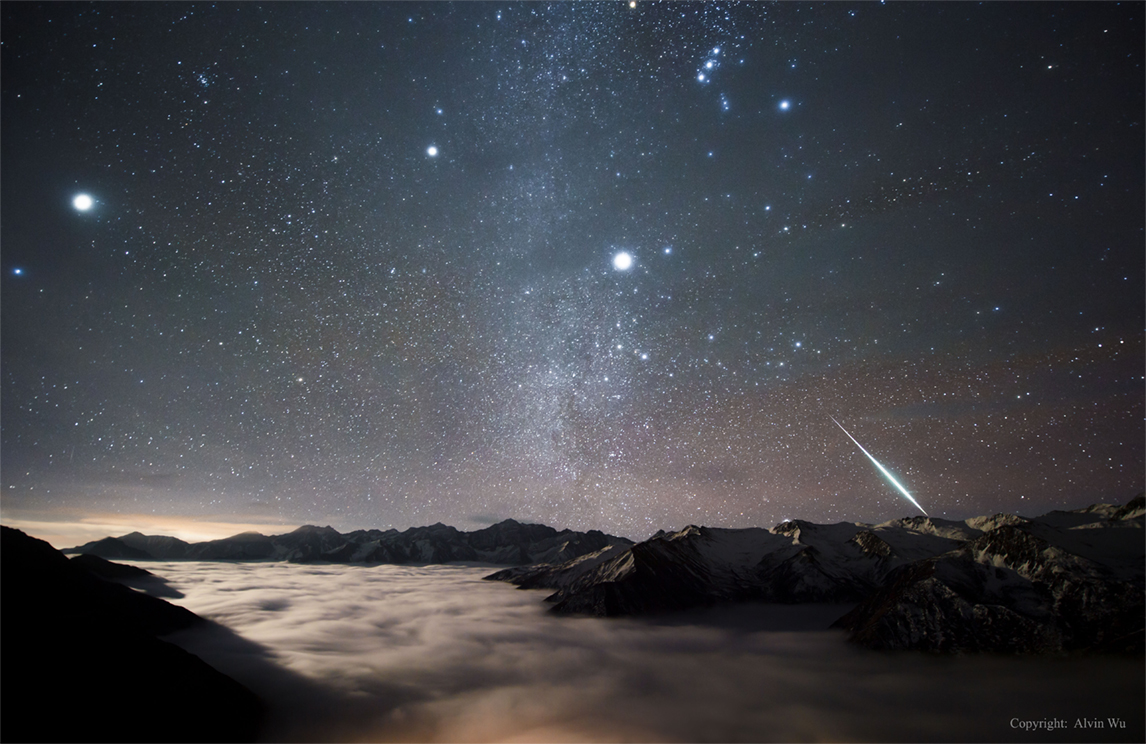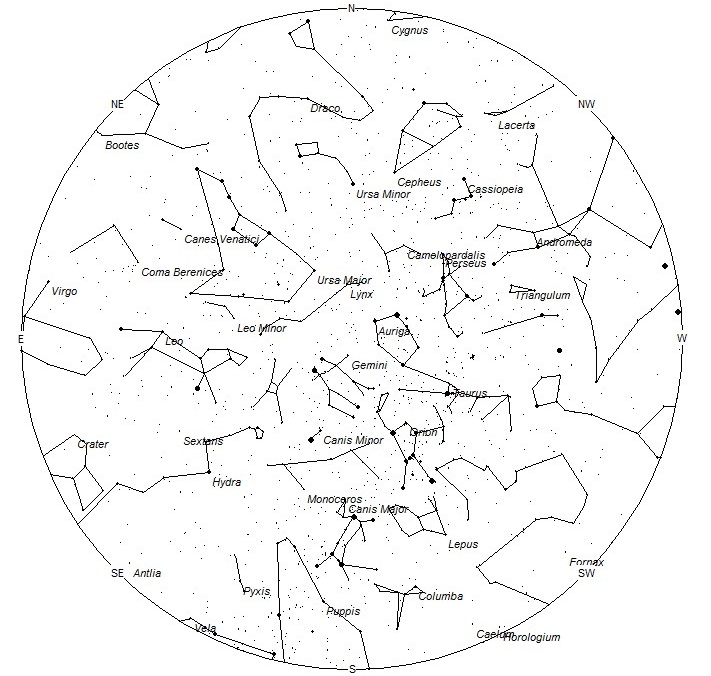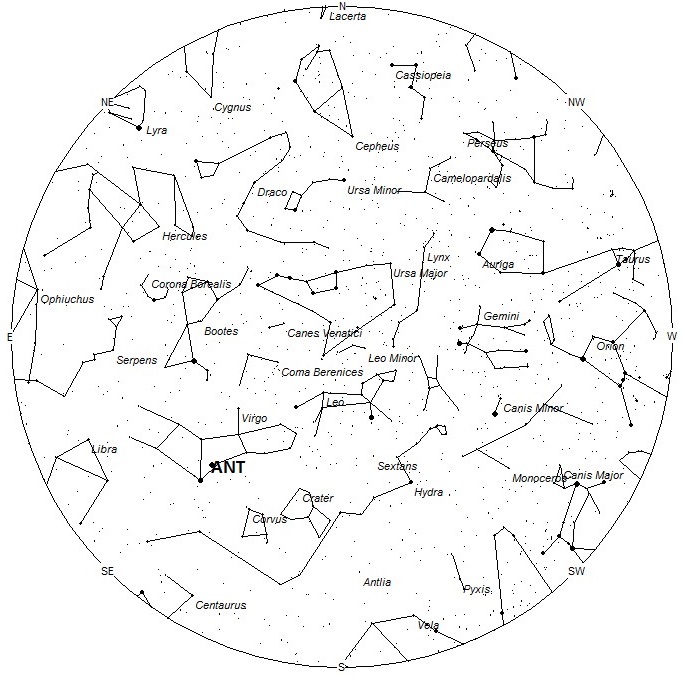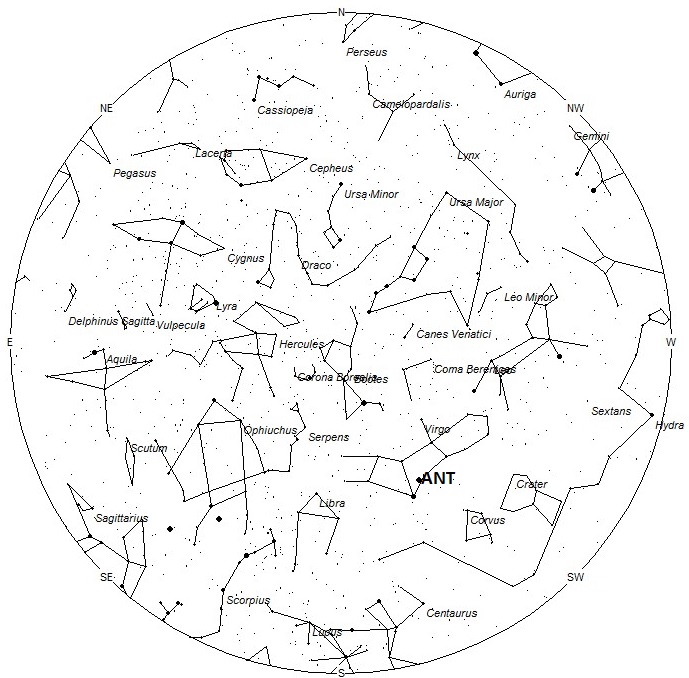
During this period the moon reaches its last quarter phase on Monday March 20. At this time the half-illuminated moon is located 90 degrees west of the sun and rises between 0100 and 0200 local daylight saving time (DST) as seen from mid-northern latitudes. The moon will interfere with meteor observing during this period if it lies within your field of view during observations. If you face away from the moon you will have better luck viewing meteor activity. The estimated total hourly meteor rates for evening observers this week is near 3 for those viewing from the northern hemisphere and 4 for those located south of the equator. For morning observers the estimated total hourly rates should be near 6 as seen from mid-northern latitudes (45N) and 9 as seen from tropical southern locations (25S). Morning rates are reduced by moonlight during this period. The actual rates will also depend on factors such as personal light and motion perception, local weather conditions, alertness and experience in watching meteor activity. Note that the hourly rates listed below are estimates as viewed from dark sky sites away from urban light sources. Observers viewing from urban areas will see less activity as only the brightest meteors will be visible from such locations.
The radiant (the area of the sky where meteors appear to shoot from) positions and rates listed below are exact for Saturday night/Sunday morning March 18/19. These positions do not change greatly day to day so the listed coordinates may be used during this entire period. Most star atlases (available at science stores and planetariums) will provide maps with grid lines of the celestial coordinates so that you may find out exactly where these positions are located in the sky. A planisphere or computer planetarium program is also useful in showing the sky at any time of night on any date of the year. Activity from each radiant is best seen when it is positioned highest in the sky, either due north or south along the meridian, depending on your latitude. It must be remembered that meteor activity is rarely seen at the radiant position. Rather they shoot outwards from the radiant so it is best to center your field of view so that the radiant lies at the edge and not the center. Viewing there will allow you to easily trace the path of each meteor back to the radiant (if it is a shower member) or in another direction if it is a sporadic. Meteor activity is not seen from radiants that are located below the horizon. The positions below are listed in a west to east manner in order of right ascension (celestial longitude). The positions listed first are located further west therefore are accessible earlier in the night while those listed further down the list rise later in the night.
These sources of meteoric activity are expected to be active this week.
The center of the large Anthelion (ANT) radiant is currently located at 12:52 (193) -06. This position lies in central Virgo, just west of the brilliant planet Jupiter. Due to the large size of this radiant, Anthelion activity may also appear from Crater and Corvus as well as Virgo. This radiant is best placed near 0200 (DST), when it lies on the meridian and is located highest in the sky. Rates at this time should be near 2 per hour no matter your location. With an entry velocity of 30 km/sec., the average Anthelion meteor would be of slow velocity.
The Gamma Normids (GNO) should be active from the 23rd through the 28th with maximum activity occurring near the 24th. The expected radiant at maximum lies near the position 16:24 (246) -51. This position is located in eastern Norma, close to the spot occupied by the 4th magnitude star known as Gamma 2 Normae. These activity dates and position are different than what you will see printed in other lists as it is based on video data from Australia. Recent observations during the old activity period has revealed little activity from this source so I am confident that these new parameters are closer to reality. This radiant is best placed near 0500 LDT when it lies highest above the horizon. Rates at maximum should be less than 1 per hour as seen from the northern hemisphere and perhaps near 1 as seen from the southern hemisphere. With an entry velocity of 68 km/sec., the average meteor from this source would be of swift velocity.
As seen from the mid-northern hemisphere (45N) one would expect to see approximately 4 sporadic meteors per hour during the last hour before dawn as seen from rural observing sites. Evening rates would be near 2 per hour. As seen from the tropical southern latitudes (25S), morning rates would be near 8 per hour as seen from rural observing sites and 3 per hour during the evening hours. Locations between these two extremes would see activity between the listed figures.
| SHOWER | DATE OF MAXIMUM ACTIVITY | CELESTIAL POSITION | ENTRY VELOCITY | CULMINATION | HOURLY RATE | CLASS |
| RA (RA in Deg.) DEC | Km/Sec | Local Daylight Saving Time | North-South | |||
| Anthelion (ANT) | – | 12:52 (193) -06 | 30 | 01:00 | 2 -2 | II |
| Gamma Normids (GNO) | Mar 25 | 16:24 (246) -51 | 68 | 05:00 | <1 – 1 | IV |
 American Meteor Society
American Meteor Society



I just saw a falling star sitting on my back porch facing north. It appeared above the roof of the house north of me. Flared from blue to yellow , larger to smaller before going below the roof top. There is desert north of my house. It looked so close I think it may be found.
I live in San tan valley, AZ 85140
I was in the vehicle coming home and I witnessed something I never have before. I watched a green shooting star come into sight and as quick as it was there it vanished.
Absolutely beautiful.
Saw a Meteorite as I was driving to work this morning. It was still dark out side and I was heading north on 495 towards Tysons Corner. I saw a light coming down from the sky and it just seem to burn out some place near where 66 of the inner beltway and 495 come together.
The night before last I was driving west on highway interstate 40 and it was pitch black last night and all of a sudden the whole situation lit up bright as all heck and a green bright light fell from the sky at an angle like a falling star but very green. Then disappeared on the other side of the hill. I was going up a hill at the moment. Scared me never seen anything like it.
Saw what I think was t meteor March 23rd 2017 close to midnight. It. took about 7 seconds to flair from the horizon to directly over my head then slowed to what almost seemed a complete stop for another 2 seconds then dissapeared. Nashville Tn.
I usually see meteors in the night sky, and saw one from west to east across the Northern sky on the 6th standing in the back of my house (S of Tucson, AZ), but on the 9th of April, the night before Passover, I saw a shooting star (Disneyland style and bright ) from South to North across the Eastern sky. I have never seen one that bright. I take my oldest dog out from 11 pm to midnight usually. It seems a busy year. I saw three this spring and usually am blessed only to see one.